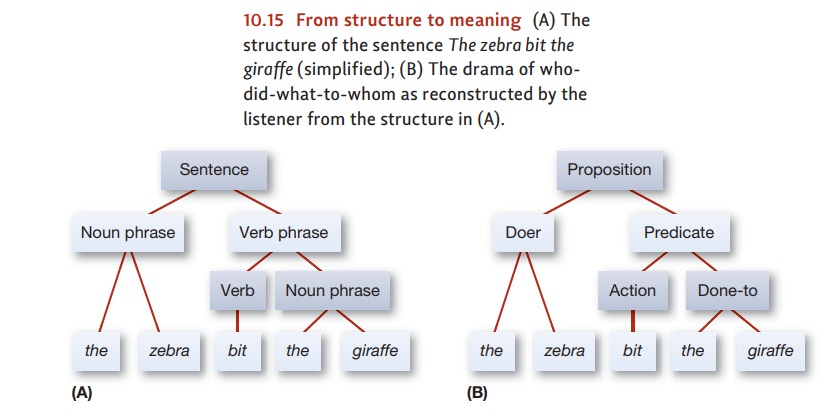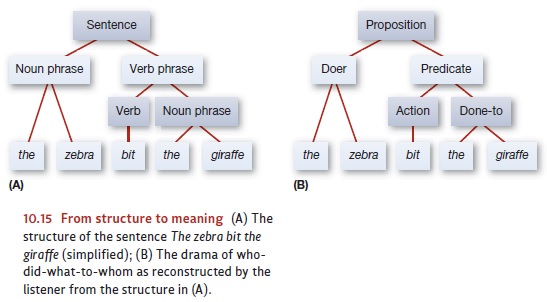Chapter: Psychology: Language
Psychology Language: The Meanings of Sentences

The Meanings of
Sentences
Sentences have meanings too, over
and above the meanings of the words they contain. This is obvious from the fact
that two sentences can be composed of all and only the same words and yet be
meaningfully distinct. For example, The
giraffe bit the zebra and The zebra
bit the giraffe describe different events, a meaning difference of some
impor-tance, at least to the zebra and the giraffe.
The typical sentence introduces
some topic (the subject of the
sentence) and then makes some comment, or offerunderstand a sentence, then, is
to determine which actors are portraying the various roles and what the plot
(the action) is; that is, to decide on the basis of sentence structure who did
what to whom.
For the very simplest sentences
of a language, their grammatical structure links up rather directly to the
semantics of who-did-what-to-whom (M. C. Baker, 2001; Grimshaw, 1990;
Jackendoff, 2002). To get a feel for how this system works, see Figure 10.15A,
which shows the phrase structure of the zebra
sentence. We can “read” the semantic roles off of this syntactic tree by
attending to its geometry, as shown in Figure 10.15B. The doer of the action is
the noun phrase that branches directly from the root of the tree (a position
known as “the sentence subject,” namely, the
zebra). The “done-to” is the noun phrase that branches off of the verb
phrase (a position known as “the direct object,” namely, the giraffe). So different noun phrases in the syntactic struc-ture
have different semantic roles. More complex sentences of the language will
encode yet further semantic roles and relations, for example, The nanny (do-er) feeds (act) somesoup (done-to,
or thing affected) to the baby (recipient) with a spoon (instrument).

Summarizing, the position of the
words and phrases in this simple sentence of English is providing the semantic
role information to the listener. Serialization is of cen-tral importance in
this regard in English and many other languages. However, there is another type
of information, used in the English pronoun system, that can signal the
semantic roles without regard to serial position. For instance, the sentences He hadalways admired her intelligence andHer intelligence is what he had always
admired mean thesame thing. It is the particular form of a pronoun (he versus him, she versus her) that assigns the semantic roles in
this case. Many languages use something analogous to our pronoun system as the
primary means for signaling semantic roles, for nouns as well as pronouns. They
do this with case markers, which
usually occur as function morphemes. When case markers occur regularly in a
language, the word order itself can be much more flexible than it is in
English. In Finnish, for example, the words meaning zebra and giraffe change
their serial order in Seepra puri
kirahvia and Kirahvia puri seepra,
but in either order it is the giraffe (kirahvia)
who needs the medical attention. It is the suffix -a (rather than -ia) that
in both sentences identifies the zebra as the aggressor in this battle.
COMPLEX SENTENCE MEANINGS
In very simple sentences, as we
have seen, the phrase structure straightforwardly reflects the propositional
meaning of who-did-what-to-whom. But the sentences we encounter in everyday
conversation are usually much more complicated than these first examples. Many
factors contribute to complexity. Sometimes we reorder the phrases so as to
emphasize aspects of the scene other than the doer (It was the giraffe who got bittenby the zebra). Sometimes we wish
to question (Who bit the giraffe?) or
command (Bite that giraffe!) rather
than merely comment on the passing scene. And often we wish tos some
information, about that topic (the predicate).
Thus, when we say, The giraffe bit the
zebra, we introduce the giraffe as the topic, and then we propose or predicate of the giraffe that it bit the zebra. Accordingly,
sentence meanings are often called propositions.
In effect, a simple sentence describes a minia-ture drama in which the verb is
the action and the nouns are the performers, each playing a different semantic role. In The zebra bit the giraffe, the zebra plays the role of doer or
agent who causes or instigates the action, the giraffe is the done-to—the thing
affected by the action, and biting is the action itself. The job of a listener
who wants to express our attitudes (beliefs, hopes, and so forth) toward
certain events (I was delightedto hear
that the zebra bit the giraffe), or to relate one proposition to another,
and so willutter two or more of them in the same sentence (The zebrathat arrived from
Kenyabitthe giraffe). All this
added complexity of meaning is mirrored by corresponding com-plexities in the
sentence structures themselves.
Most ordinary language users
fluently utter, write, and understand many sentences 50, 100, or more morphemes
in length. The example below is from a blogger writing about ordering beauty
supplies on line—so we can hardly protest that it was the unusual creation of
some linguistic Einstein or literary giant:
However, I didn’t know how to order it and came across your site
where you found free trial supplies which is great because i dont want to pay
for something i didnt know worked
This author has managed to cram
nine verbs in four different tenses into an infor-mal but intricate grammatical
narrative. How did he or she manage to do it? Surely not by memorizing
superficial recipes like “an English sentence can end with two verbs in a row”
but rather by nonconsciously appreciating combinatorial regularities of
enor-mous generality and power that build up sentence units like acrobats’
pyramids. The complex sentences are constructed by reusing the same smallish
set of syntax rules that formed the simple sentences, but tying them all
together using function morphemes for the nails and glue (Chomsky, 1959, 1981a;
Z. Harris, 1951; Joshi, 2002).
AMBIGUITY IN WORDS AND SENTENCES
Not only do sentences often
become complex. Very often a sentence can be interpreted more than one way: It
is ambiguous. Sometimes, the ambiguity depends only on one word having two or
more meanings (that is, having more than one “entry” in our men-tal dictionaries);
examples can be seen in such newspaper headlines as Children’s StoolsUseful for Garden Work; Red Tape Holds up Bridge;
Prostitutes Appeal to Pope. In many cases,though, the ambiguity depends on
structure: in particular, on alternate ways that words are grouped together in
the syntactic tree (Police Are Ordered to
Stop Drinking on Campus;Oil Given Free to Customers in Glass Bottles).
There is a big difference, after all, betweenpolice who [stop drinking] [on
campus] and those who [stop] [drinking on campus].*
Such structural ambiguity is
pervasive in everyday speech and writing, even with short and apparently simple
sentences. For instance, Smoking
cigarettes can be dangerous could be a warning that to inhale smoke could
harm your health, or a warning that if you leave your butt smoldering in an
ashtray, your house might burn down.
Related Topics